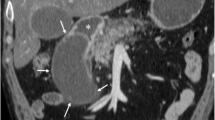Abstract
Objective
To estimate the incidence of missed gastroduodenal ulcers on routine abdominal computed tomography (CT) and identify findings and methods to improve sensitivity of CT interpretation for peptic ulcers.
Materials and methods
This is a retrospective chart and imaging review. Two blinded readers independently reviewed CTs performed within 7 days prior to endoscopy of 114 subjects; this included 57 consecutive subjects with proven gastroduodenal ulcers intermixed with 57 subjects with endoscopically normal examinations. Presence, location and size of ulcer crater, and ancillary findings (mural edema, asymmetric wall thickening, focal fat stranding, regional lymph nodes, and extraluminal gas) were recorded before and after review of multiplanar reformatted images. Radiology reports were then reviewed to determine if an ulcer was identified prospectively.
Results
Thirty-one ulcers (54%) were radiographically occult, missed by both readers. Thirteen ulcers were correctly and independently identified by both readers (sensitivity/specificity = 30%/100%). With review of multiplanar reformats, sensitivity and accuracy increased for both readers. When two or more ancillary findings were identified, the odds ratio of a true ulcer being present was greater than 5.6 (P = 0.0001). Both size and location of ulcer were important for detection; readers were more likely to identify gastric ulcers compared to duodenal or marginal ulcers (P = 0.02). Only 3/13 definitely visible ulcers were correctly identified during initial CT interpretation.
Conclusions
Although CT has low sensitivity for peptic ulcer disease, the miss rate for visible peptic ulcers is high. Increased awareness, multiplanar imaging review, and identification of ancillary findings may improve sensitivity for gastroduodenal ulcers.

Similar content being viewed by others
References
Kurata JH, Nogawa AN (1997) Meta-analysis of risk factors for peptic ulcer. Nonsteroidal antiinflammatory drugs, Helicobacter pylori, and smoking. J Clin Gastroenterol 24(1):2–17
Malfertheiner P, Chan FK, McColl KE (2009) Peptic ulcer disease. Lancet 374(9699):1449–1461. doi:10.1016/S0140-6736(09)60938-7
Malfertheiner P, Megraud F, O’Morain C, et al. (2007) Current concepts in the management of Helicobacter pylori infection: the Maastricht III Consensus Report. Gut 56(6):772–781. doi:10.1136/gut.2006.101634
Marshall BJ, Warren JR (1984) Unidentified curved bacilli in the stomach of patients with gastritis and peptic ulceration. Lancet 1(8390):1311–1315
Lau JY, Sung J, Hill C, et al. (2011) Systematic review of the epidemiology of complicated peptic ulcer disease: incidence, recurrence, risk factors and mortality. Digestion 84(2):102–113. doi:10.1159/000323958
Committee ASoP, Banerjee S, Cash BD, et al. (2010) The role of endoscopy in the management of patients with peptic ulcer disease. Gastrointest Endosc 71(4):663–668. doi:10.1016/j.gie.2009.11.026
Jacobs JM, Hill MC, Steinberg WM (1991) Peptic ulcer disease: CT evaluation. Radiology 178(3):745–748. doi:10.1148/radiology.178.3.1994412
Kaye MD, Young SW, Hayward R, Castellino RA (1980) Gastric pseudotumor on CT scanning. AJR Am J Roentgenol 135(1):190–193. doi:10.2214/ajr.135.1.190
Fishman EK, Urban BA, Hruban RH (1996) CT of the stomach: spectrum of disease. Radiographics 16(5):1035–1054. doi:10.1148/radiographics.16.5.8888389
Gossios KJ, Tsianos EV, Demou LL, et al. (1991) Use of water or air as oral contrast media for computed tomographic study of the gastric wall: comparison of the two techniques. Gastrointest Radiol 16(4):293–297
Horton KM, Fishman EK (1998) Helical CT of the stomach: evaluation with water as an oral contrast agent. AJR Am J Roentgenol 171(5):1373–1376. doi:10.2214/ajr.171.5.9798881
Winter TC, Ager JD, Nghiem HV, et al. (1996) Upper gastrointestinal tract and abdomen: water as an orally administered contrast agent for helical CT. Radiology 201(2):365–370. doi:10.1148/radiology.201.2.8888224
Broder JS, Hamedani AG, Liu SW, Emerman CL (2013) Emergency department contrast practices for abdominal/pelvic computed tomography-a national survey and comparison with the american college of radiology appropriateness criteria(®). J Emerg Med 44(2):423–433. doi:10.1016/j.jemermed.2012.08.027
Laituri CA, Fraser JD, Aguayo P, et al. (2011) The lack of efficacy for oral contrast in the diagnosis of appendicitis by computed tomography. J Surg Res 170(1):100–103. doi:10.1016/j.jss.2011.02.017
Paulson EK, Jaffe TA, Thomas J, Harris JP, Nelson RC (2004) MDCT of patients with acute abdominal pain: a new perspective using coronal reformations from submillimeter isotropic voxels. AJR Am J Roentgenol 183(4):899–906. doi:10.2214/ajr.183.4.1830899
Paulson EK, Harris JP, Jaffe TA, Haugan PA, Nelson RC (2005) Acute appendicitis: added diagnostic value of coronal reformations from isotropic voxels at multi-detector row CT. Radiology 235(3):879–885. doi:10.1148/radiol.2353041231
Horton KM, Fishman EK (2003) Current role of CT in imaging of the stomach. Radiographics 23(1):75–87. doi:10.1148/rg.231025071
Pickhardt PJ, Asher DB (2003) Wall thickening of the gastric antrum as a normal finding: multidetector CT with cadaveric comparison. AJR Am J Roentgenol 181(4):973–979. doi:10.2214/ajr.181.4.1810973
Scatarige JC, DiSantis DJ (1989) CT of the stomach and duodenum. Radiol Clin N Am 27(4):687–706
Hammerman AM, Mirowitz SA, Susman N (1989) The gastric air-fluid sign: aid in CT assessment of gastric wall thickening. Gastrointest Radiol 14(2):109–112
Conflict of interest
We have no financial disclosures.
Author information
Authors and Affiliations
Corresponding author
Rights and permissions
About this article
Cite this article
Allen, B.C., Tirman, P., Tobben, J.P. et al. Gastroduodenal ulcers on CT: forgotten, but not gone. Abdom Imaging 40, 19–25 (2015). https://doi.org/10.1007/s00261-014-0190-1
Published:
Issue Date:
DOI: https://doi.org/10.1007/s00261-014-0190-1




